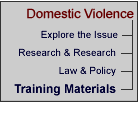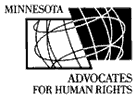|
|
|
DOMESTIC VIOLENCE TRAINING MATERIALS The United Nations, Council of Europe and European Union have all recommended training programs as a vital part of efforts to combat domestic violence. A comprehensive training program should focus on a variety of professionals whose work is connected with domestic violence and include training initiatives that range from general awareness-raising to specific policy development and implementation. The Beijing Platform for Action recommends that governments take action to “create, improve or develop as appropriate, and fund the training programmes for judicial, legal, medical, social, educational and police and immigrant personnel, in order to avoid the abuse of power leading to violence against women and sensitize such personnel to the nature of gender-based acts and threats of violence so that fair treatment of female victims can be assured.” Other key actors who would benefit from training programs include politicians, the media, students and the general public. This site offers sample introductory-level training sessions on the definition of domestic violence as a violation of women’s human rights as well as more in-depth sessions that address the causes, effects, and dimensions of the problem. The sample training sessions included here are intended to illustrate a few training exercises and are not meant to be exhaustive. The creation of specific training sessions on the implementation of laws or the development of particular initiatives to address domestic violence must be carried out at the national level and must reflect current country conditions. For this reason, the sessions included on this site that focus on training participants on aspects of the legal framework or assisting participants in developing strategies to address the problem are written at a more generalized level and must be adapted. All training programs, whether aimed at general education or high-level strategizing, should be part of a comprehensive and coordinated approach to combating domestic violence. Training programs should be adapted to the local needs of each country and should reflect the specific country conditions and target audience(s). For example, facilitators should be aware of the existence of domestic laws and policy on domestic violence, initiatives to coordinate the community response to domestic violence and regional projects that include the country in which the training will take place. Finally, advocates may find it useful to familiarize themselves with a general training methodology, included in Guidelines for Developing a Training Program. The Guidelines provide the necessary background information for understanding the sample training materials on trafficking in women included on this site.
|





